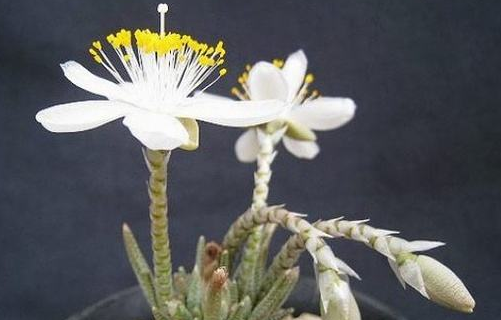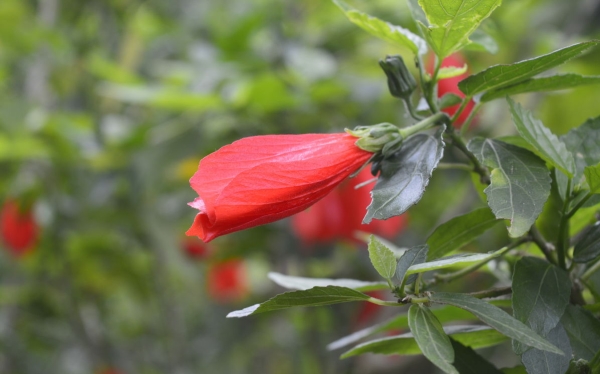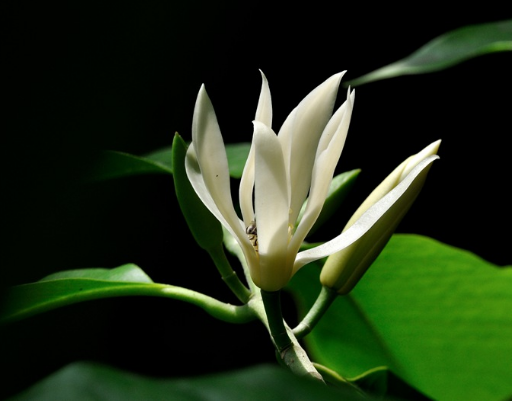How to raise White Flower tenderness Brocade
1. Soil for planting
If we are cutting white flower brocade, we need to choose loose and fertile soil, and in order to prevent stagnant water and root breathing, our soil also needs to have good drainage and ventilation, so that there will not be stagnant water in the basin soil, and the roots can breathe normally, like the garden soil of our community mixed with some rotten leaf soil, which is very easy to find.

2. Lighting for a long time
As we all know, succulent plants love light, especially in the spring and autumn or the growing season, we rest assured to put the white blossom brocade outside the window to enjoy the sun, because at this time the climate is pleasant and the temperature is not high is very conducive to the growth of succulent plants. However, in summer, due to the high temperature and strong sun, it is easy to be sunburned by the sun in words like this, and it is easy to cause local temperature rise, so it is easy to dormancy, so we have no way to maintain it.
So we have to put it in a ventilated place at noon in summer to reduce the temperature to avoid dormancy. In winter, because the temperature is low, we can not maintain it outdoors, we can only put it in the window, and we should keep the temperature and bask in the sun.
3. Pay attention to water control
Succulent white flower tenderness brocade we all know to water less when we are conserving, each watering needs to be watered according to the dry and wet condition of the basin soil, and every time we have to let the basin soil dry and then water it, watering thoroughly at one time, not over and over again. After watering, we also need to put the plants in a cool and ventilated place and let the water dry, which will reduce the stagnant water in the basin. Water is usually watered every 5-7 days in spring and autumn, 3-5 days in summer, 7-10 days if dormant, and almost once every half a month in winter.
4. Appropriate fertilizer
Fertilizing the succulent plant can help it grow better during the growing period, such as Baihua Chunjin will blossom in spring and autumn, so it will be easier for us to blossom after fertilization. at the same time, fertilizer can also increase the fertilizer lost in the soil and lay the foundation for future growth. at the same time, it also has the effect of enhancing plant resistance.
The above describes how the white flower brocade is raised, and let's take a look at how it propagates.
Introduction to the breeding method and matters needing attention of Avonia quinaria Avonia quinaria Brocade is a succulent plant of Portulacaceae, perennial herbs with tuberous roots, and white and red flowers. The morphological characteristics of phloem brocade have irregular rhizomes (commonly known as "tuberous roots"), the tip is clustered with small branches, the twigs are wrapped in white and green scalelike leaflets, leaves with stipules, are papery stipules, enclosing fine leaves. With a base of 5, the flowering period is very short, and some species bloom for only an hour. Tenacity belongs to self-pollination, about three weeks of maturity. The phloem brocade flower is in the shape of a plum blossom, born at the top of the twig, about 2 cm in diameter, the stamens are longer, often exceeding the petals, with golden anthers at the top, and the petals are silky and white. The flower is plum-shaped, born at the top of the twig, the petals are silky, white or red, usually open after sunny evening and closed at night, but it is difficult to blossom in case of rainy days or insufficient light in the cultivation place. the life span of each flower is only 1 to 2 hours. Open in summer. Single plant blossoms for 7 to 10 days. People often use "a flash in the pan" to describe the short life span of plant flowers. in fact, the life span of many plant flowers is shorter than that of epiphyllum, and the brocade is one of them. It takes less than 2 hours from blooming to closing, because its florescence is short, and the plant has not been introduced into our country for a long time. Cultivation is not very common, and few people have seen its flowers. It usually opens in the sunny afternoon and closes at night. The life span of each flower is only 4-5 hours. It is difficult to open in case of rainy days or insufficient light in the cultivation environment. The flowering period is from May to July. There are small branches on the top of the white blossom brocade, and the twigs are covered with white and green scalelike leaflets. The flowers are plum-shaped, born at the top of the twigs, and the petals are silky, white or red. They usually open after sunny evening and close at night. In case of rainy days or lack of light in the cultivation place, it is difficult to blossom. The life span of each flower is only 1 to 2 hours and blooms in summer. Single plant blossoms for 7 to 10 days. Its peculiar shape, small branches and simple rhizomes reflect each other into interest, very much like stone anemones attached to the rocks, but also like dancing silver snakes, and the plant type is small, growing slowly, like living handicrafts, suitable for planting in small pots, placed in the sun, windowsill and other places, watch carefully in leisure, appreciate its magical charm. The ecological habits of Bengjin are native to the desert areas of South Africa and Namibia. It likes cool, dry and sunny environment, and is resistant to drought, stagnant water, muggy and humid, and slightly cold-resistant. The distribution area of Bengjin is native to the desert areas of South Africa and Namibia. The garden use of tenderbrocade is peculiar in shape, with small branches and simple roots, much like stone sea anemones attached to rocks and dancing silver snakes, with small plants and slow growth, like living handicrafts, suitable for planting in small pots, placed in sunshine, windowsills and other places, watching them carefully in their spare time and enjoying its magical charm. The variety classification of phloem brocade can be divided into two types: White flower and safflower. The scientific name of white flower tough brocade is: Avonia quinaria subsp. Alstoni Carthamus tinctorius (A.alstonii), whose flowers are deep pink and whose other characteristics are basically the same as those of Brocade. Similar species of the same genus are silver silkworm (A.albissima), also known as goblin dance, with fleshy short stems, clustered fine round branches, densely covered with scalelike spiral leaflets; snow Chang'e (A.papyracea), also known as White Snake Hall, fleshy stems are short, stem tips are much branched, oblique or curved extending to the ground, stem surface white papery leaflets, tip white-green florets. Safflower phloem brocade (A.alstonii), the flower is deep pink, the safflower phloem brocade scientific name is: Avonia quinaria subsp. Quinaria synonym: the other characteristics of Anacampseros quinaria are basically the same as those of Bengjin. Similar species of the same genus are silver silkworm (A.albissima), also known as goblin dance, with fleshy short stems, clustered fine round branches, densely covered with scalelike spiral leaflets; snow Chang'e (A.papyracea), also known as White Snake Hall, fleshy stems are short, stem tips are much branched, oblique or curved extending to the ground, stem surface white papery leaflets, tip white-green florets. The way of propagation of Brocade is the method of sowing. The cultivation technique of Brocade is native to the desert of South Africa. It likes cool, dry and sunny environment, and is resistant to drought, stagnant water, muggy and humid, and slightly cold. The main growth period is from the end of September to April of the following year, when the twigs at the top of the rhizome begin to germinate and grow, which can be maintained in a place with sufficient sunshine. Watering should be mastered "no dry, no watering, watering thoroughly" to avoid stagnant water in the soil so as not to cause root rot. Because of its slow growth and little need for nutrients, it is generally not necessary to apply additional fertilizer. Controlled watering in winter can withstand a low temperature of about 5 ℃. In summer, pay attention to good ventilation, avoid rain, strict control of watering, so as to avoid muggy and humid, basin soil caused by rot. The basin soil requires loose air permeability, good drainage and a certain particle size, which can be mixed with rotten leaf soil or peat, coarse sand or vermiculite, mixed with a small amount of bone powder and other calcareous materials, and can also be planted with red jade soil and other materials. Photo of Blossom Brocade / Carthamus tinctorius Picture: how to cultivate / propagate Portulaca L. in Chinese: Latin name: Avonia alstoni Korean name:? Family and genus: Portulaca: small and slow-growing plant, native to the desert areas of South Africa and Namibia, like cool, dry and sunny environment, resistant to drought, afraid of stagnant water, but also afraid of hot and humid, slightly cold-resistant. The blossom is in the shape of a plum blossom and grows at the top of a twig. The flowers are white or red. The method of reproducing by sowing. Watering table January, February, March, May, June, July, August, October, November, December, April, April, June, July, September, November, November, December, December, November, December, November, December Each flower has a life span of only one to two hours and blooms in summer. Single plant blossoms for 7 to 10 days. Its peculiar shape, small branches and simple rhizomes reflect each other into interest, very much like stone anemones attached to the rocks, but also like dancing silver snakes, and the plant type is small, growing slowly, like living handicrafts, suitable for planting in small pots, placed in the sun, windowsill and other places, watch carefully in leisure, appreciate its magical charm. People often use "a flash in the pan" to describe the short life span of plant flowers. in fact, the life span of many plant flowers is shorter than that of epiphyllum, and the brocade is one of them. It takes less than 2 hours from blooming to closing, because its florescence is short, and the plant has not been introduced into our country for a long time. Cultivation is not very common, and few people have seen its flowers. It usually opens in the sunny afternoon and closes at night. The life span of each flower is only 4-5 hours. It is difficult to open in case of rainy days or insufficient light in the cultivation environment. The flowering period is from May to July. The other characteristics of Carthamus tinctorius are basically the same as those of Phloem brocade. Similar species of the same genus are silver silkworm (A.albissima), also known as goblin dance, with fleshy short stems, clustered fine round branches, densely covered with scalelike spiral leaflets; snow Chang'e (A.papyracea), also known as White Snake Hall, fleshy stems are short, stem tips are much branched, oblique or curved extending to the ground, stem surface white papery leaflets, tip white-green florets. Bengjin is native to the desert region of South Africa, and its main growth period is from the end of September to April of the following year, when the twigs at the top of the rhizome begin to germinate and grow, which can be maintained in a place with plenty of sunshine. "do not dry or water, water thoroughly" to avoid stagnant water in the soil so as not to cause root rot. Because of its slow growth and little need for nutrients, it is generally not necessary to apply additional fertilizer. Controlled watering in winter can withstand a low temperature of about 5 ℃. In summer, pay attention to good ventilation, avoid rain, strict control of watering, so as to avoid muggy and humid, basin soil caused by rot. The basin soil requires loose air permeability, good drainage and a certain particle size, which can be mixed with rotten leaf soil or peat, coarse sand or vermiculite, mixed with a small amount of bone powder and other calcareous materials, and can also be planted with red jade soil and other materials. The method of reproducing by sowing.
- Prev

Culture method of Platanus orientalis
Soil Platanus orientalis is suitable to be planted in fertile, well-drained sandy soil, and it is best to plant it in decaying soil. The hanging bell flower likes a warm and humid environment, it is not resistant to cold, so put it in an environment with plenty of light. In this way, the plant can grow thicker, if the light is not enough.
- Next

Culture method of white orchid
The soil of white orchid should be loose and fertile, drained and breathable and rich in humus. The granular soils with different shapes have better permeability and drainage. The selection of flowerpots is also marked with good air permeability, and mud pots, purple sand pots and plastic pots with many bottom holes can be selected.
Related
- Fuxing push coffee new agricultural production and marketing class: lack of small-scale processing plants
- Jujube rice field leisure farm deep ploughing Yilan for five years to create a space for organic food and play
- Nongyu Farm-A trial of organic papaya for brave women with advanced technology
- Four points for attention in the prevention and control of diseases and insect pests of edible fungi
- How to add nutrient solution to Edible Fungi
- Is there any good way to control edible fungus mites?
- Open Inoculation Technology of Edible Fungi
- Is there any clever way to use fertilizer for edible fungus in winter?
- What agents are used to kill the pathogens of edible fungi in the mushroom shed?
- Rapid drying of Edible Fungi

